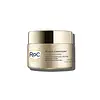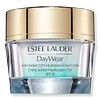RoC Retinol Correxion Line Smoothing Max Hydration Cream Versus Estée Lauder DayWear Anti-Oxidant 72H-Hydration Sorbet Creme SPF 15
What's inside
What's inside
 Key Ingredients
Key Ingredients

 Benefits
Benefits

 Concerns
Concerns

 Ingredients Side-by-side
Ingredients Side-by-side

Water
Skin ConditioningPentaerythrityl Tetraethylhexanoate
EmollientGlycerin
HumectantPPG-15 Stearyl Ether
EmollientDimethicone
EmollientButylene Glycol
HumectantDimethicone Crosspolymer
Emulsion StabilisingCaprylyl Glycol
EmollientGlyceryl Behenate
EmollientRetinol
Skin ConditioningSodium Hyaluronate
HumectantTocopherol
AntioxidantAscorbyl Palmitate
AntioxidantAscorbic Acid
AntioxidantHydrolyzed Myrtus Communis Leaf Extract
Skin ProtectingCeteareth-20
CleansingPolyacrylamide
Cetearyl Alcohol
EmollientStearyl Alcohol
EmollientPentylene Glycol
Skin ConditioningAllyl Methacrylates Crosspolymer
Emulsion StabilisingC13-14 Isoparaffin
EmollientPolysorbate 20
EmulsifyingSodium Polyacrylate
AbsorbentIsododecane
EmollientHydroxyphenyl Propamidobenzoic Acid
Skin ConditioningSodium Acryloyldimethyltaurate/Vp Crosspolymer
Emulsion StabilisingCaprylhydroxamic Acid
Laureth-7
EmulsifyingBHT
AntioxidantPhenoxyethanol
PreservativeEthylhexylglycerin
Skin ConditioningDisodium EDTA
Sodium Hydroxide
BufferingWater, Pentaerythrityl Tetraethylhexanoate, Glycerin, PPG-15 Stearyl Ether, Dimethicone, Butylene Glycol, Dimethicone Crosspolymer, Caprylyl Glycol, Glyceryl Behenate, Retinol, Sodium Hyaluronate, Tocopherol, Ascorbyl Palmitate, Ascorbic Acid, Hydrolyzed Myrtus Communis Leaf Extract, Ceteareth-20, Polyacrylamide, Cetearyl Alcohol, Stearyl Alcohol, Pentylene Glycol, Allyl Methacrylates Crosspolymer, C13-14 Isoparaffin, Polysorbate 20, Sodium Polyacrylate, Isododecane, Hydroxyphenyl Propamidobenzoic Acid, Sodium Acryloyldimethyltaurate/Vp Crosspolymer, Caprylhydroxamic Acid, Laureth-7, BHT, Phenoxyethanol, Ethylhexylglycerin, Disodium EDTA, Sodium Hydroxide
Butyl Methoxydibenzoylmethane 2%
UV AbsorberHomosalate 4%
Skin ConditioningEthylhexyl Salicylate 4.5%
UV AbsorberOctocrylene 2%
UV AbsorberGlycerin
HumectantAlcohol Denat.
AntimicrobialPentylene Glycol
Skin ConditioningCaprylyl Methicone
Skin ConditioningBiosaccharide Gum-1
HumectantAmmonium Acryloyldimethyltaurate/Vp Copolymer
Cucumis Sativus Fruit Extract
EmollientSodium Hyaluronate
HumectantThermus Thermophillus Ferment
Skin ConditioningEthylbisiminomethylguaiacol Manganese Chloride
AntioxidantErgothioneine
AntioxidantTocopheryl Acetate
AntioxidantTetrahexyldecyl Ascorbate
AntioxidantCyclodextrin
AbsorbentPsidium Guajava Fruit Extract
AstringentCaffeine
Skin ConditioningNarcissus Tazetta Bulb Extract
AstringentPolygonum Cuspidatum Root Extract
AntioxidantAlgae Extract
EmollientHelianthus Annuus Seed Extract
Skin ConditioningVitis Vinifera Seed Extract
AntimicrobialTriticum Vulgare Germ Extract
Skin ConditioningHordeum Vulgare Extract
EmollientGentiana Lutea Root Extract
Skin ConditioningLinoleic Acid
CleansingCholesterol
EmollientGlycyrrhetinic Acid
Skin ConditioningSaccharomyces Lysate Extract
HumectantPalmitoyl Hydroxypropyltrimonium Amylopectin/Glycerin Crosspolymer
Skin ConditioningArtemia Extract
Skin ConditioningPropylene Glycol Dicaprate
EmollientEthylhexylglycerin
Skin ConditioningTocopherol
AntioxidantPropanediol
SolventSqualane
EmollientGlucose
HumectantAcrylates/C10-30 Alkyl Acrylate Crosspolymer
Emulsion StabilisingButylene Glycol
HumectantLecithin
EmollientCitric Acid
BufferingSodium Hydroxide
BufferingParfum
MaskingDisodium EDTA
BHT
AntioxidantSodium Benzoate
MaskingPhenoxyethanol
PreservativeCI 42090
Cosmetic ColorantButyl Methoxydibenzoylmethane 2%, Homosalate 4%, Ethylhexyl Salicylate 4.5%, Octocrylene 2%, Glycerin, Alcohol Denat., Pentylene Glycol, Caprylyl Methicone, Biosaccharide Gum-1, Ammonium Acryloyldimethyltaurate/Vp Copolymer, Cucumis Sativus Fruit Extract, Sodium Hyaluronate, Thermus Thermophillus Ferment, Ethylbisiminomethylguaiacol Manganese Chloride, Ergothioneine, Tocopheryl Acetate, Tetrahexyldecyl Ascorbate, Cyclodextrin, Psidium Guajava Fruit Extract, Caffeine, Narcissus Tazetta Bulb Extract, Polygonum Cuspidatum Root Extract, Algae Extract, Helianthus Annuus Seed Extract, Vitis Vinifera Seed Extract, Triticum Vulgare Germ Extract, Hordeum Vulgare Extract, Gentiana Lutea Root Extract, Linoleic Acid, Cholesterol, Glycyrrhetinic Acid, Saccharomyces Lysate Extract, Palmitoyl Hydroxypropyltrimonium Amylopectin/Glycerin Crosspolymer, Artemia Extract, Propylene Glycol Dicaprate, Ethylhexylglycerin, Tocopherol, Propanediol, Squalane, Glucose, Acrylates/C10-30 Alkyl Acrylate Crosspolymer, Butylene Glycol, Lecithin, Citric Acid, Sodium Hydroxide, Parfum, Disodium EDTA, BHT, Sodium Benzoate, Phenoxyethanol, CI 42090
 Reviews
Reviews

Ingredients Explained
These ingredients are found in both products.
Ingredients higher up in an ingredient list are typically present in a larger amount.
BHT is a synthetic antioxidant and preservative.
As an antioxidant, it helps your body fight off free-radicals. Free-radicals are molecules that may damage your skin cells.
As a preservative, it is used to stabilize products and prevent them from degrading. Specifically, BHT prevents degradation from oxidation.
The concerns related to BHT come from oral studies; this ingredient is currently allowed for use by both the FDA and EU.
However, it was recently restricted for use in the UK as of April 2024.
Learn more about BHTButylene Glycol (or BG) is used within cosmetic products for a few different reasons:
Overall, Butylene Glycol is a safe and well-rounded ingredient that works well with other ingredients.
Though this ingredient works well with most skin types, some people with sensitive skin may experience a reaction such as allergic rashes, closed comedones, or itchiness.
Learn more about Butylene GlycolDisodium EDTA plays a role in making products more stable by aiding other preservatives.
It is a chelating agent, meaning it neutralizes metal ions that may be found in a product.
Disodium EDTA is a salt of edetic acid and is found to be safe in cosmetic ingredients.
Learn more about Disodium EDTAEthylhexylglycerin (we can't pronounce this either) is commonly used as a preservative and skin softener. It is derived from glyceryl.
You might see Ethylhexylglycerin often paired with other preservatives such as phenoxyethanol. Ethylhexylglycerin has been found to increase the effectiveness of these other preservatives.
Glycerin is already naturally found in your skin. It helps moisturize and protect your skin.
A study from 2016 found glycerin to be more effective as a humectant than AHAs and hyaluronic acid.
As a humectant, it helps the skin stay hydrated by pulling moisture to your skin. The low molecular weight of glycerin allows it to pull moisture into the deeper layers of your skin.
Hydrated skin improves your skin barrier; Your skin barrier helps protect against irritants and bacteria.
Glycerin has also been found to have antimicrobial and antiviral properties. Due to these properties, glycerin is often used in wound and burn treatments.
In cosmetics, glycerin is usually derived from plants such as soybean or palm. However, it can also be sourced from animals, such as tallow or animal fat.
This ingredient is organic, colorless, odorless, and non-toxic.
Glycerin is the name for this ingredient in American English. British English uses Glycerol/Glycerine.
Learn more about GlycerinPentylene glycol is typically used within a product to thicken it. It also adds a smooth, soft, and moisturizing feel to the product. It is naturally found in plants such as sugar beets.
The hydrophilic trait of Pentylene Glycol makes it a humectant. As a humectant, Pentylene Glycol helps draw moisture from the air to your skin. This can help keep your skin hydrated.
This property also makes Pentylene Glycol a great texture enhancer. It can also help thicken or stabilize a product.
Pentylene Glycol also acts as a mild preservative and helps to keep a product microbe-free.
Some people may experience mild eye and skin irritation from Pentylene Glycol. We always recommend speaking with a professional about using this ingredient in your routine.
Pentylene Glycol has a low molecular weight and is part of the 1,2-glycol family.
Learn more about Pentylene GlycolPhenoxyethanol is a preservative that has germicide, antimicrobial, and aromatic properties. Studies show that phenoxyethanol can prevent microbial growth. By itself, it has a scent that is similar to that of a rose.
It's often used in formulations along with Caprylyl Glycol to preserve the shelf life of products.
Sodium Hyaluronate is hyaluronic acid's salt form. It is commonly derived from the sodium salt of hyaluronic acid.
Like hyaluronic acid, it is great at holding water and acts as a humectant. This makes it a great skin hydrating ingredient.
Sodium Hyaluronate is naturally occurring in our bodies and is mostly found in eye fluid and joints.
These are some other common types of Hyaluronic Acid:
Learn more about Sodium HyaluronateSodium Hydroxide is also known as lye or caustic soda. It is used to adjust the pH of products; many ingredients require a specific pH to be effective.
In small amounts, sodium hydroxide is considered safe to use. However, large amounts may cause chemical burns due to its high alkaline.
Your skin has a natural pH and acid mantle. This acid mantle helps prevent harmful bacteria from breaking through. The acid mantle also helps keep your skin hydrated.
"Alkaline" refers to a high pH level. A low pH level would be considered acidic.
Learn more about Sodium HydroxideTocopherol (also known as Vitamin E) is a common antioxidant used to help protect the skin from free-radicals and strengthen the skin barrier. It's also fat soluble - this means our skin is great at absorbing it.
Vitamin E also helps keep your natural skin lipids healthy. Your lipid skin barrier naturally consists of lipids, ceramides, and fatty acids. Vitamin E offers extra protection for your skin’s lipid barrier, keeping your skin healthy and nourished.
Another benefit is a bit of UV protection. Vitamin E helps reduce the damage caused by UVB rays. (It should not replace your sunscreen). Combining it with Vitamin C can decrease sunburned cells and hyperpigmentation after UV exposure.
You might have noticed Vitamin E + C often paired together. This is because it is great at stabilizing Vitamin C. Using the two together helps increase the effectiveness of both ingredients.
There are often claims that Vitamin E can reduce/prevent scarring, but these claims haven't been confirmed by scientific research.
Learn more about Tocopherol